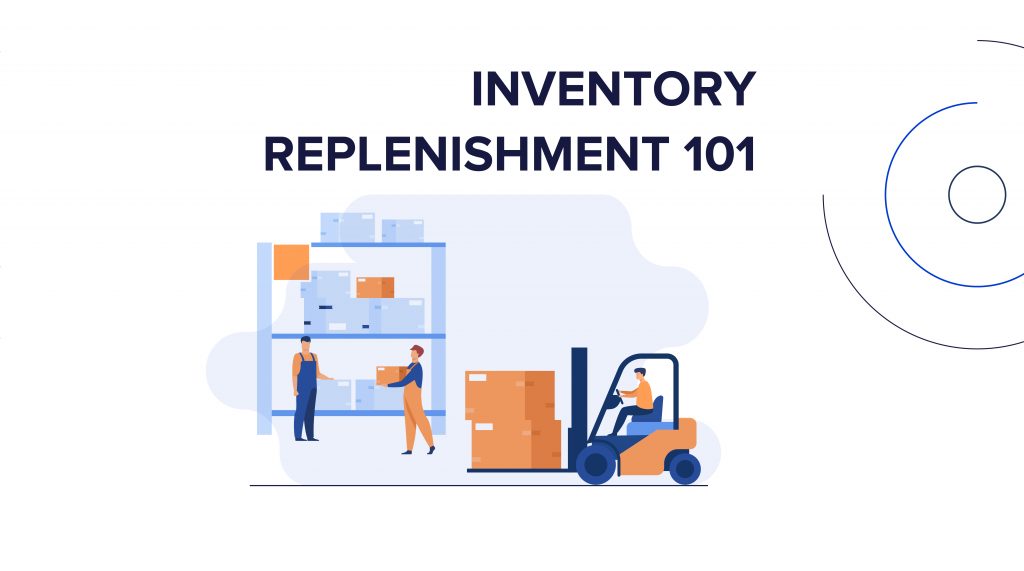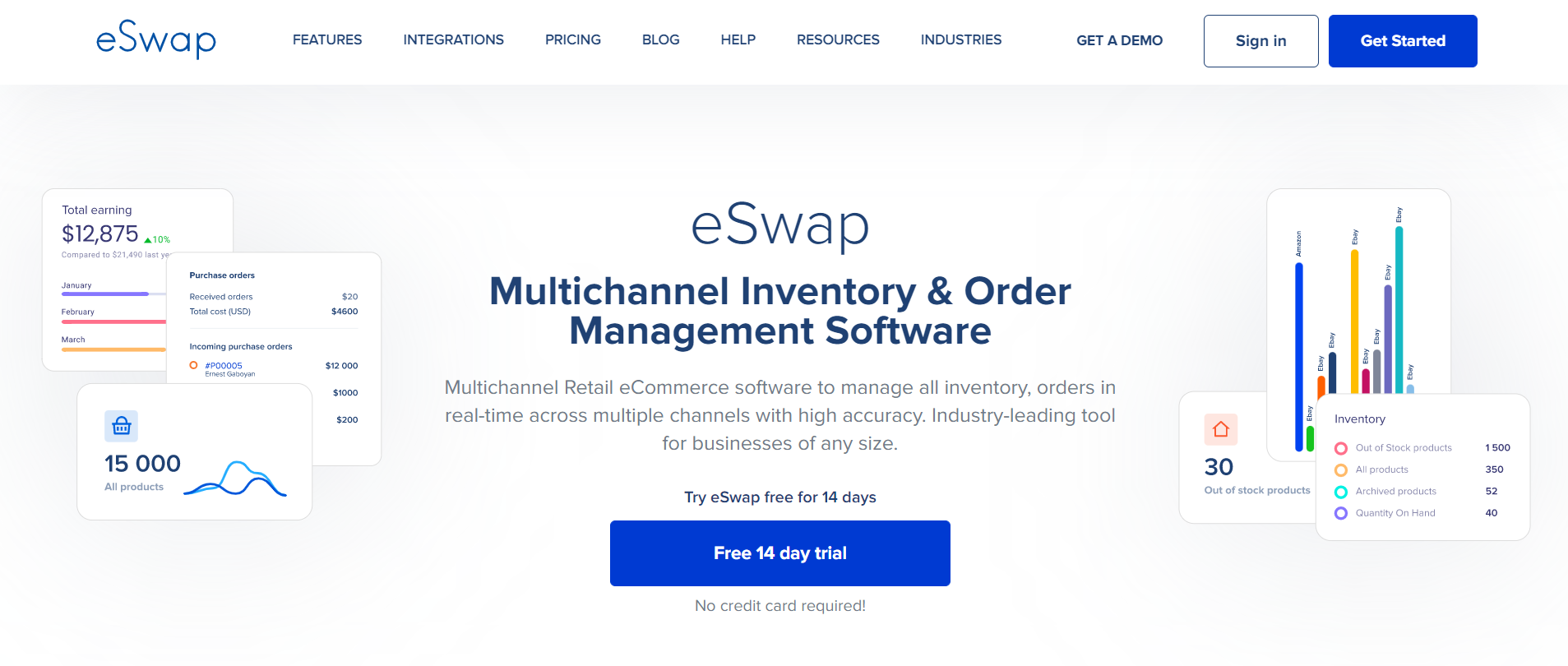Inventory replenishment is how businesses systematically take necessary measures to deliver items down the supply chain to keep stock levels consistent. Without an effective strategy, companies can quickly find themselves out of stock and lose customers. Statistics claim that reducing supply chain costs from 9% to 4% will result in double profits. Replenishing inventory plays a significant role in achieving this goal.

Thus, today’s article will explore some inventory replenishment methods and tips for success.
Why Does Inventory Replenishment Matter?
The term “restocking” can refer to both inventory ready for sale and raw materials received from suppliers. It is vital to precisely manage the inventory replenishment process so you will have enough inventory on hand to pick and pack each order as soon as it arrives.
An important aspect to consider is that businesses must have a robust replenishment strategy to avoid costly supply chain problems such as out-of-stock inventory and overstock.
Stockouts
A stockout occurs when a retailer fails to restock inventory at the right moment, resulting in products and services being out of stock at the time of purchase. Consistent stockouts can result in lost sales and dissatisfied customers.
Overstocks
On the other hand, overstocking is when a business replenishes inventory beyond what they need, leading to excess inventory and wasted storage space. Extra carrying costs and potential markdowns on products that may expire or become obsolete are the least of the problems.
Excess inventory may stymie new product launches. Overstocking merchandise may become unsellable if left unattended for too long. For example, perishable foods, drinks, cosmetics, and other products with an expiration dates can cause serious challenges for your business.
Overstocking can also lead to supply chain breakdown. Understanding that brands must commit extra investments to handle additional inventory is crucial. This, in turn, might cause several issues, such as replenishing stock too early.
Backorders
Backorders occur with replenishment delays, causing a product to be unavailable at the time of purchase. Stockouts and backorders can cause unpleasant experiences for your consumers. Not only can they result in a waste of valuable resources, but they can also drastically affect consumer loyalty and overall trust in your company. As a result, a company gets lost sales and a damaged reputation.
So, to minimize frequent stockout difficulties, it is vital to have backup inventory in case of emergencies. Having a safety stock can also assist you when unexpected errors arise in the supply chain of your business.
Inventory Replenishment vs Inventory Control
Although these two are interrelated, replenishing inventory and inventory control are different.
Inventory replenishment focuses on maintaining stock levels, while inventory control aims to track and monitor inventory at all times. Keeping everything under control means being in charge of allocating inventory to suitable locations, maintaining accurate records, and analyzing inventory levels.
Inventory control methods and strategies are essential to replenishment as they assist in knowing when and how much inventory should be replenished. Thus, both play a crucial role in efficient supply chain management operations.
Professional Advice
While some replenishment methods include replenishing inventory on a fixed schedule, such as weekly or monthly, it is important to have an agile strategy interconnected with management software. This will reduce replenishment time and adapt the process as necessary, taking into account emerging trends and changes in customer demand.
Utilizing inventory management software can assist with replenishment planning and forecasting, ultimately resulting in better inventory control.
Inventory Replenishment Methods and Strategies to Borrow

Businesses can use various inventory replenishment methods depending on their specific needs and goals. We will further discuss several approaches you could adopt and implement today.
Reorder Point Technique
Inventory reorder point methods guarantee that you have a good product on hand to meet client demand at all times.
The technique implies that replenishment orders are placed when the quantity of a product reaches a certain level, known as the “reorder point.” It relies on the past replenishment history, average daily sales and lead time to determine the reorder point.
Ordering too frequently can be costly regarding replenishment expenses and warehousing space, while ordering too infrequently can lead to stockouts. The reorder point method can help strike a balance between replenishment costs and stockouts.
Reorder points also provide retailers additional financial freedom by ensuring they always have a minimum amount of goods on hand. Based on previous order data, the reorder point formula lets you determine the proper stock levels to fulfill customer demand so you know how much and when to restock.
Reorder Point = (average daily usage x lead time) + safety stock
Top-off Replenishment Strategy
A top-off replenishment strategy brings the stock to an acceptable level at front-picking points.
Each fixed picking point has the minimum and maximum thresholds in this case. Using this method, inventory levels for a particular product are “topped off” in their appropriate storage locations during slower times or downtime, allowing you to have a high inventory turnover rate without having to worry about stockouts for pickers.
The top-off approach is the most appropriate inventory replenishment strategy when your inventory contains many fast-moving SKUs.
Periodic Inventory Replenishment
A periodic inventory replenishment implies replenishment orders are placed at regular intervals, regardless of the inventory level. For instance, you review the stock levels every three months to determine if they need to be replenished.
When stock levels fall below the bare minimum, there is a need for another replenishment. Periods help maintain a steady replenishment flow and prevent inventory problems, such as stockouts.
The periodic replenishment method is suitable for slow-moving products with low expenses. It can also be a good option for businesses with limited storage space and financial resources to invest in safety stock or additional inventory.
Demand Management Strategy
Demand management strategy is perhaps one of the most apparent and straightforward methods many organizations adopt.
With a demand management strategy, restocking or reordering restrict to only what’s required to fulfill orders.
Safety stock is the ultimate solution for preventing stockouts, but it may not always be feasible for a business. The demand replenishment method is more cost-effective and helps avoid excess inventory.
It’sIt’s critical to stay organized and track inventory levels in all replenishment methods, whether through software or a traditional pen-and-paper approach.
Professional Advice
As stock replenishment is vital to running a successful business, staying up to date with the latest replenishment methods and technologies is essential. Allocating resources for advanced inventory management tools can significantly assist replenishment processes and prevent future supply chain problems. Platforms like eSwap can automate replenishment and track stock levels, saving time and money in the long run.
Factors Impacting Replenishing Inventory

Even professionally prepared companies can face
unpredicted issues. Factors such as unexpected spikes in demand, warehouse space shortages, and supplier delays can impact replenishment processes.
Price and Demand Spikes
Sudden spikes in demand can lead to stockouts and potentially lost sales. Customers tend to switch to competitors if they cannot find the right product, leading to brand damage and lost loyalty.
Similarly, price fluctuations can also impact replenishment. Sudden price changes can lead to replenishment delays and potentially missed opportunities for savings.
Warehouse Space Shortages
Having enough warehouse space is crucial for replenishment. Limited warehouse space can lead to overcrowding, which diminishes the efficiency of inventory management and replenishment processes. It can also potentially result in damage if products are crammed together.
Supplier Delays
Supplier delays can ripple effect replenishment, leading to stockouts and missed customer orders. It’s important to establish strong communication with suppliers and monitor their performance in delivering replenishment orders.
Using Data for Replenishment
It is essential to use data to enhance the performance of inventory replenishment and your overall business.
Using data can help you make financially and strategically more informed decisions and optimize your inventory management.
For instance, accounts data will help you understand what products sell faster and which take more time. You will also figure out whether your reorder frequency matches the demands. Your team can enhance demand forecasts and inventory management by analyzing this data.
Keep in mind that accurate demand and lead time projections reduce the chances of a stockout or backorder. Moreover, you will decrease the probability of receiving more products than they can handle.
The Role of Inventory Management Systems
Technology doesn’t stand still. New replenishment methods, advanced inventory management tools, and software can greatly assist businesses in replenishment processes and prevent future supply chain problems.
Inventory management systems can automate replenishment and track stock levels, potentially saving time and money in the long run. These systems can also provide critical replenishment data and inventory analysis, allowing for more informed decision-making.
Let us introduce you closer to eSwap, which will become your go-to professional guide with inventory management. Platforms like eSwap control inventory levels, conduct precise restocking, have fast and trustworthy shipping, and more.

Managing shipping operations helps streamline replenishment and ensure that products reach their destinations on time. Manual data entry and order tracking are not an option for eCommerce retailers using eSwap! The software integrates with leading shipping carriers, such as UPS and FedEx.
Also, it allows for a completely automated workflow. From analytics and reporting to catalog and warehouse management – the system has all the tools you need to keep your business running smoothly.
Inventory Replenishment with Eswap
As stock replenishment is vital to running a successful eSwap includes replenishment features that allow automatic reordering based on current stock levels and sales data. The platform has a simple yet professional warehouse management function that will enable retailers to manage their inventory across several locations.
This feature allows you to control the status of your goods from a single dashboard. It includes all parts of inventory management, including selection, packaging, shipping, and receiving new goods. The warehouse management feature will also allow you to access valuable data regarding out-of-stock or low-stock products.
Ecommerce shipping strategies combined with efficient replenishment processes can make or break your business. Don’t let inventory replenishment be a headache for your team – let eSwap handle it for you. Sign up for a free trial today to see how our platform can enhance replenishment and inventory management for your eCommerce business.







